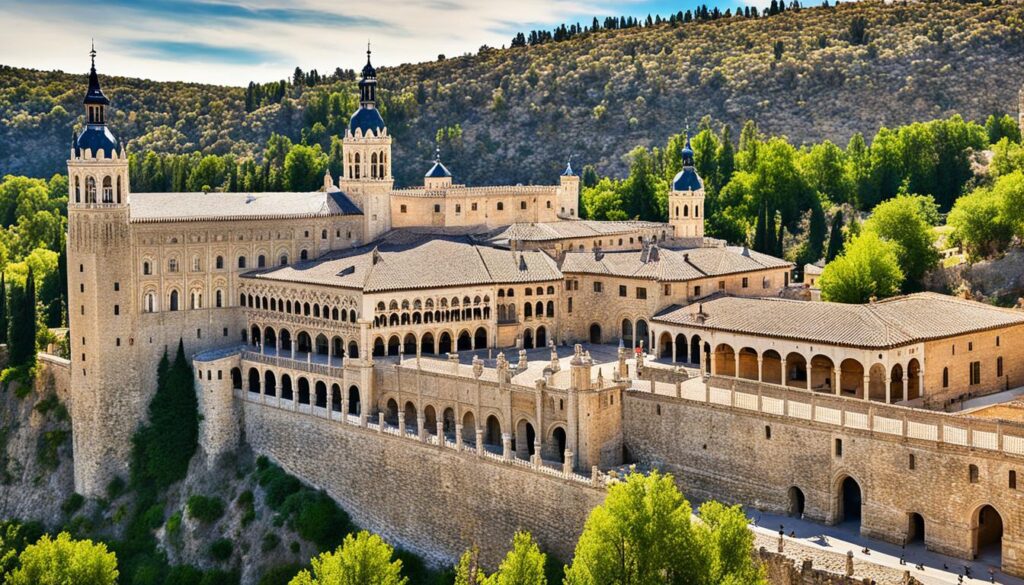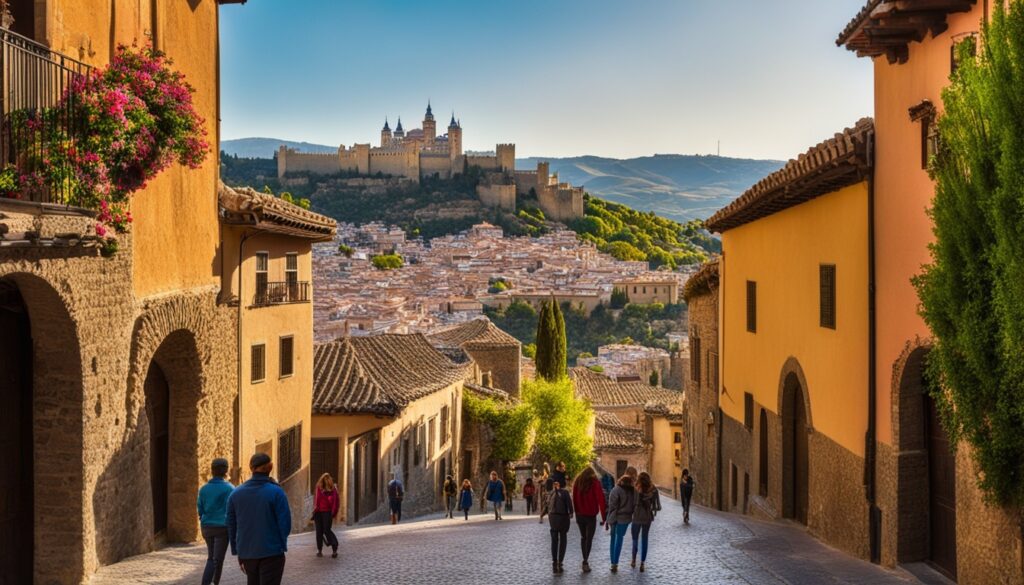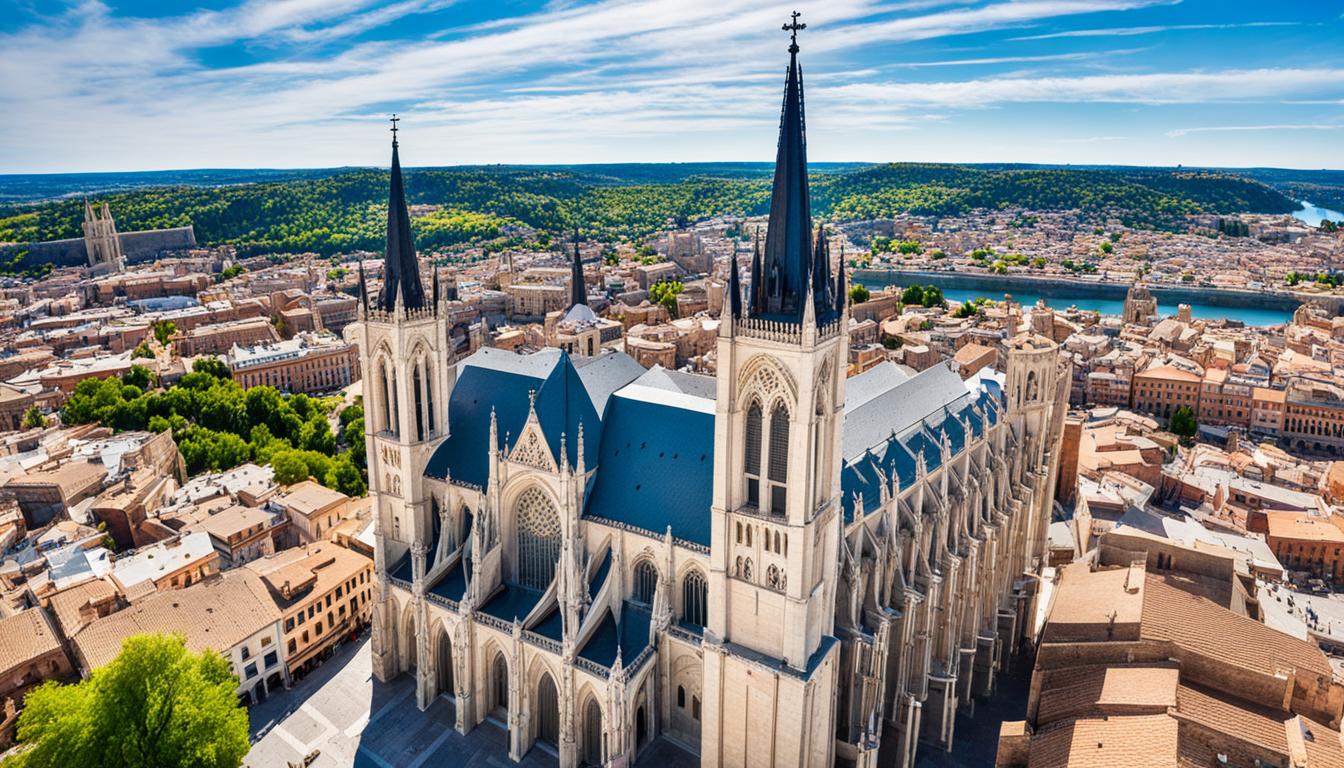Toledo sits on a hill above the Río Tajo, offering stunning views. It’s filled with architectural marvels, cobblestone streets, and deep cultural history. The city’s toledo spain architecture mixes Moorish, Gothic, Mudejar, and Renaissance styles. This shows how Christian, Muslim, and Jewish communities lived together peacefully for years.
Key Takeaways
- Toledo is famous for its toledo spain architectural heritage, with a mix of different styles.
- The city’s historic center uses Islamic design to catch cool breezes and provide shade.
- Toledo’s toledo architecture tells the story of a place where different cultures met.
- Iconic sites like the Toledo Cathedral, built in the 13th century, highlight the city’s toledo historic architecture.
- Visitors can see Toledo’s architectural wonders on guided tours and at night when it’s lit up.
Introduction to Toledo’s Architectural Heritage
In the heart of Spain lies the historic city of Toledo. It’s famous for its stunning toledo architectural heritage and toledo historic architecture. The city sits on a rocky mound, looking over the Río Tajo gorge. Its center is full of churches, mosques, synagogues, and historic houses. Each one shows the city’s long and interesting toledo multi-cultural architecture.
Nestled in the Heart of Spain
Toledo is in a special spot, with cliffs and a winding river. This has helped keep its historic center well-preserved. It inspired famous painter El Greco and is called “the city of three cultures.” This name comes from the peaceful living of Christian, Muslim, and Jewish people. Their influence on the city’s buildings is clear.
A City of Three Cultures
Toledo’s buildings show its rich, mixed culture. Each group brought its own style to the city’s look. You’ll see Mudéjar art, Gothic cathedrals, and Renaissance and Baroque buildings. Together, they make Toledo’s cityscape a mix of history and culture.
“Toledo is a city that contains within itself all the beauty and all the tragedy of Spain.” – Gregorio Marañón, Spanish physician and historian
Islamic Architecture in Toledo
Toledo, a city in central Spain, is known for its diverse architecture. It has a lot of islamic architecture. The Mosque of Cristo de la Luz is a key example. It’s from the 11th century and shows the Mudéjar style, mixing Moorish and Christian designs.
Mosque of Cristo de la Luz
The Mosque of Cristo de la Luz is now a church. It’s a symbol of Toledo’s Islamic past. It has the typical horseshoe arches and detailed patterns seen in Moorish architecture. The main dome is special, with a star-shaped support system that shows the smart engineering of the time.
Mudéjar Style and Influence
In Toledo, the toledo mudejar architecture is everywhere. Moorish craftsmen built many of Toledo’s beautiful buildings. This style mixed Islamic and Christian designs, creating Mudéjar architecture. It’s known for its beautiful decorations and smart use of light and space.
“The incorporation of Islamicate architectural forms in the Toledo Cathedral can be seen as a gesture of triumphalism, signifying the victory of Christianity over Islam, while also acknowledging the authority of Andalusi culture.”
Gothic Architecture Marvels
Toledo, the ancient capital of Spain, is famous for its Gothic architecture. This architecture shows the city’s deep cultural roots. At its center is the towering Toledo Cathedral, a wonder that has amazed people for ages.
The Towering Toledo Cathedral
Building the Toledo Cathedral started in 1227 and lasted about 250 years. It combines Gothic and Mudéjar styles beautifully. The cathedral’s gothic architecture features ribbed vaults, pointed arches, and a stunning Mudéjar wooden ceiling in the chapter house.
The cathedral’s size and beauty are awe-inspiring. It reaches 105 meters high, with twin towers and a detailed facade. These features make it a symbol of medieval art and engineering skill.
“The Toledo Cathedral is a true testament to the enduring legacy of gothic architecture in toledo. Its stunning design and meticulous craftsmanship continue to captivate and inspire visitors from around the world.”
The Toledo Cathedral is a top example of toledo gothic architecture. It shows the city’s rich culture and the lasting impact of Gothic architecture in Spain.
Renaissance and Baroque Architectural Gems
Toledo is known for its Gothic and Islamic architecture, but it also has Renaissance and Baroque buildings. These show the city’s mix of cultures. The Alcázar fortress and the Iglesia de los Jesuitas are two examples of this change.
The Majestic Alcázar Fortress
The Alcázar fortress started in the 10th century as an al-qasr (fortress). It was rebuilt in the Renaissance as a royal home. Now, it’s a symbol of toledo renaissance architecture.
Its design is grand and symmetrical, with beautiful interiors. This shows the skill and care of the Renaissance.
Iglesia de los Jesuitas
The toledo baroque architecture of the Iglesia de los Jesuitas is different from the city’s old buildings. The church has a white interior with beautiful details and big arches. It feels peaceful and uplifting, despite its deep history and importance.
| Architectural Feature | Alcázar Fortress | Iglesia de los Jesuitas |
|---|---|---|
| Origins | 10th century al-qasr (fortress) | Baroque-style Jesuit church |
| Architectural Style | toledo renaissance architecture | toledo baroque architecture |
| Key Characteristics | Grand, symmetrical facade, impeccable interiors | Classical all-white interior, ornate details, grand arches |
These buildings show Toledo’s lasting architectural beauty. They mix different cultures into a beautiful whole.

toledo spain architecture
Toledo’s architecture tells the story of its rich history and cultural mix. The city’s buildings show off different styles like Islamic Mudéjar, Gothic, Renaissance, and Baroque. This mix shows how Toledo has changed over time.
The city’s historic center is small and has narrow cobblestone streets. It sits on a hill, making it unique. This setting adds to Toledo’s special look.
Diverse Architectural Styles
Toledo has many buildings from different times, like Roman, Visigoth, Islamic, Christian, and Jewish. You can see Roman aqueducts, Islamic mosques, and Jewish synagogues. These landmarks show the city’s varied history.
The Cathedral of Toledo, started in 1226, combines Gothic and Mudejar styles. The Hospital de Tavera, in Florentine Renaissance style, has a church made of Genoese marble. It also has historical documents and famous art. The Alcazar, once a Roman palace, is now the Army Museum.
Blending of Architectural Influences
The Synagogue Santa Maria La Blanca, from 1180, is one of Europe’s oldest synagogues. It shows a mix of Christian, Islamic, and Jewish styles. The Cathedral of Toledo has a main chapel with many figures and chapels for different saints.
After the Christian conquest, Toledo built more buildings with a Moorish look. The Iglesia de Cristo de la Luz, built in 999, has Visigothic materials and Mudéjar style. It might be on the site of an old church.
The Mudéjar style, after the Christian Reconquista, is seen in some Toledo monuments, like the Real Alcazar of Seville. The Knights Hospitaller added the apse of the Iglesia de Cristo de la Luz in 1190. This shows the toledo architectural influences in the city’s buildings.
Exploring the Jewish Quarter
In the heart of Toledo lies the historic Jewish Quarter, known as the judería. This area is a treasure trove of toledo jewish quarter architecture and toledo sephardic architecture. It’s where two key synagogues stand, each telling a story of the city’s toledo synagogue architecture.
Synagogue of El Tránsito
The Synagogue of El Tránsito dates back to the 14th century. It’s a masterpiece of Mudéjar architecture. Its ceiling and windows are adorned with intricate carvings and filigree. This blend of Islamic and Christian styles is a sight to behold.
Today, it’s a museum. It lets visitors dive deep into the toledo jewish quarter architecture and the Sephardic culture of Toledo.
Synagogue of Santa María la Blanca
Close by, the Synagogue of Santa María la Blanca is another architectural marvel. Built by Mudéjar craftsmen, it looks like a mosque with its arches and tiles. This shows how Islamic and Jewish styles merged in Toledo.
These synagogues, along with the old Jewish Quarter, let visitors see the toledo sephardic architecture. They highlight the Sephardic Jewish community’s big impact on Toledo’s culture.
“The Synagogue of El Tránsito and the Synagogue of Santa María la Blanca stand as testaments to the rich toledo jewish quarter architecture and the profound impact of the Sephardic Jewish community on Toledo’s cultural heritage.”
Architectural Tours and Experiences
Toledo, a UNESCO World Heritage site, is a treasure trove of architectural wonders. It offers guided walking tours and night illumination shows. These experiences let you dive deep into the city’s rich history and design.
Guided Walking Tours
Guided walking tours in Toledo take you through its architectural gems. Experts lead these tours, sharing knowledge about the city’s varied styles. You’ll see the Mosque of Cristo de la Luz and the Primate Cathedral, among others.
Visitors also get to explore landmarks like the Synagogue of El Tránsito and the Alcázar Fortress. These tours offer a deep look into Toledo’s history and culture.
Night Illumination Shows
Toledo now has night illumination shows that highlight its architectural beauty. The Toledo Cathedral and the Iglesia de San Miguel in Cuenca are the main attractions. These shows use modern lighting and technology to make the buildings shine.
These displays are a must-see for anyone visiting Toledo. They offer a unique way to experience the city’s architecture at night. It’s an unforgettable experience that combines history with modern technology.
Toledo is a city that offers many ways to explore its architecture. Whether it’s through guided tours or night shows, you’ll find something special. From the Toledo Cathedral to the Synagogue of Santa María la Blanca, Toledo’s architecture will leave you amazed.
Practical Tips for Visiting Toledo
Toledo, a city in central Spain, is known for its stunning architecture. It draws visitors from all over the world. Here are some tips to enhance your visit.
Best Times to Visit
The best times to visit Toledo are in spring and fall. The weather is mild, and there are fewer people around. Try to avoid the summer months when it gets very hot and crowded. The city’s narrow streets and hills can be tough to handle in the heat.
Also, plan your trip to see Toledo’s cultural festivals and events. These events highlight the city’s rich history and culture.
Getting Around Toledo
The historic center of Toledo is perfect for walking. Its narrow streets and hills are not easy for cars. But, they can be tough for people with mobility issues.
Consider getting the Toledo Tourist Bracelet Pass. It gives you unlimited access to seven main monuments and attractions.
If walking is hard for you, Toledo has other ways to get around. You can use buses, taxis, or a hop-on, hop-off sightseeing bus. The city’s public transport is also good for getting to attractions outside the historic center.

Exploring Toledo is an unforgettable experience. It’s one of Spain’s most historic and captivating cities.
Preserving Toledo’s Architectural Legacy
Toledo, Spain, is deeply committed to saving its architectural past. It works hard to restore and protect historic buildings and sites. These efforts keep Toledo’s unique look alive for future visitors.
The city’s historic center covers about 260 hectares of preserved history. It shows a rich cultural tradition over 2,000 years old. Toledo’s buildings mix Visigoth, Islamic, Mudejar, and Renaissance styles, showing the city’s diverse past.
Restoration and Conservation Efforts
Toledo values its historic buildings a lot. It has strong plans to keep them looking real and true to their original form. These plans help Toledo’s culture and traditions live on.
The Cristo de la Luz Mosque is a key example of Toledo’s conservation work. It’s one of only ten mosques left from the 10th century Islamic rule. The mosque has been restored to keep its beauty and importance.
The Toledo Cathedral is another example. It’s a stunning Gothic building from the 13th century. Over the years, it has been updated in the 16th, 17th, and 18th centuries to keep it looking great.
Toledo’s synagogues, like the Synagogue of Santa María la Blanca, are also being saved. This synagogue is from the late 12th or early 13th century. Thanks to preservation, these landmarks will be here for others to see and learn from.
Toledo’s hard work in saving its architecture has been recognized. In 1940, it was named a Historic-Artistic Site. In 1987, it got UNESCO World Heritage status for its cultural value and preservation efforts.
Conclusion
Toledo’s architecture shows the city’s deep history and cultural mix. It has Islamic Mudéjar styles, Gothic cathedrals, and Renaissance fortresses. These buildings tell of the city’s growth and how different groups lived together over time.
The toledo spain architecture reflects Toledo’s lasting legacy. Each building has its own story of the city’s past. The Toledo Cathedral, Alcázar Fortress, and synagogues remind us of Toledo’s history and its effect on architecture worldwide.
Visiting Toledo’s architecture leaves a lasting impression. It shows how human creativity can blend history into our surroundings. Toledo’s buildings remind us of the power of history and creativity in our world.

